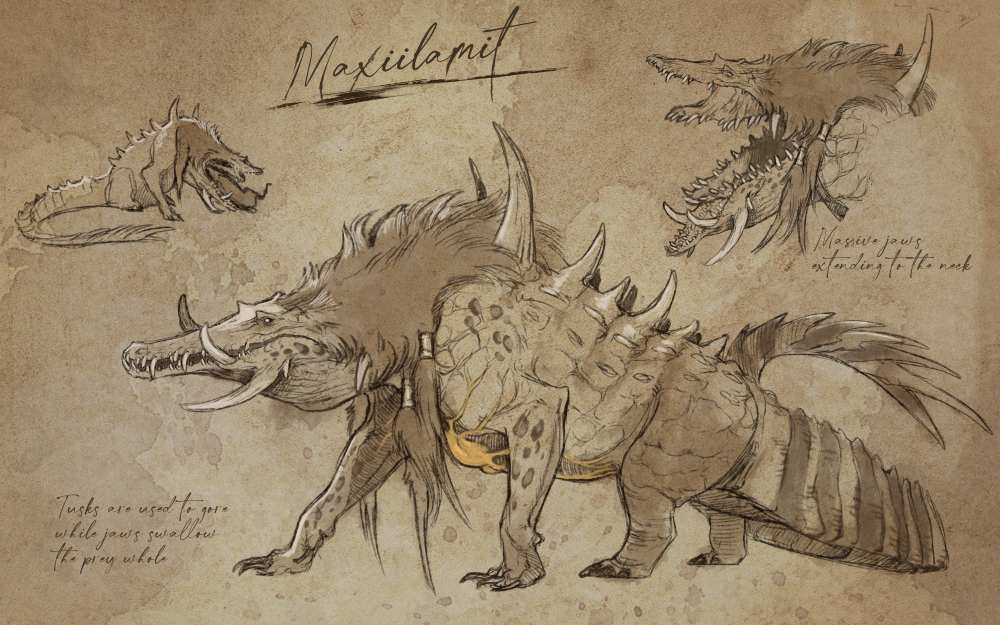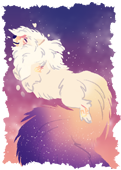Tokopedia
Maxiilamit
Description:
Maxiilamits are terrifying creatures whose mouths can open wide enough to swallow all but the largest tokotas in a single gulp. They also have considerable crushing power if that wasn't enough to deal with.
Their scientific name is Horridatura Potentaxilla, or Horrid Creature Powerful Jaw, and they are currently the only creature identified of that genus. Their common name is often shortened to Lalamit.
Maxiilamits have hair on their neck that continues to grow throughout their life. Their hair is often maintained, either braided or tied up; otherwise, it can cause discomfort or affect their ability to hunt, maneuver, and carry out their daily activities. However, this is an odd phenomenon, as they are not able to maintain their hair on their own. There are many speculations, and one of the most supported theories is that a species of small primate with nimble digits cohabits the ruins with the Maxiilamits, maintaining their hair in exchange for protection from the environment. However, there is no concrete proof up to this date, as there is no confirmed sighting of said primate.
Lore:
The appearance of Maxiilamits used to be a sign of disasters about to happen. It could be anything from forest fires to flooding. Later on, they were also associated with dark spirits.
One story has it that Maxiilamits were once much smaller, and it was only due to people chasing them away because of this association with bad luck that they grew and turned from relatively harmless animals who used the horns under their jaw to dig out roots, to the gigantic devourers of today that baitl prey right into their mouth with these horns.
Another theory is that they are a result of spiritual corruption within the ruins, a taint left on the very land itself. Or perhaps they are the vengeful spirit of a god that was once killed in the ruins.
Stories of people accidentally pulling them out of the water after mistaking the hair on their neck for human hair are relatively common, often told as a cautionary tale.
Behaviour:
Maxiilamits are ambush predators that utilize their natural camouflage to blend into the occasional fallen trees and moss-covered ruins they tend to habit. They are more active at dusk, spending most of the daytime basking under the light.
Their diet consists of large prey such as Unicorns that may be (unwisely) passing through the area, as well as smaller creatures such as Gryphons.
They rely on stealth and patience to catch their meals, staying completely still until they can lunge forward with the help of their powerful tails, catching prey with a surprising speed and intensity.
Once they grab onto their prey, a second set of interior pharyngeal jaws will proceed with chewing the victim while the outer jaws maintain the fatal grasp, making it nearly impossible to get away once you're in a Maxiilamit's jaws.
They can lay in wait for days while stalking their prey. Their bodies have adapted for extended periods of fasting, so it is quite rare for any prey to be able to outlast them.
Incidents where a Tokota has been made a meal for the Maxiilamit are not unheard of but are considered rare, mostly because of the Tokotas’ own sharp senses. However, there have been many reports of Tokotas being injured, and the smaller species such as Tokis and Tokharas are more likely to be severely injured due to their size.
While not sociable creatures, multiple individuals can share the same space if food is in abundance. However, they can become territorial when food becomes scarce.
Often the easiest way to survive a Maxiilamits is, ironically, to find more of them, and hope that they become too focused on fighting each other to hunt you down.
It is theorized they can lay in a dormant hibernation-type state for long periods of time, likely when the conditions in the caves become too harsh to sustain life, such as during glaciations or volcanic activity.
Lifecycle:
Maxiilamits are oviparous. Despite their size upon reaching adulthood, a Maxiilamit’s egg is no larger than a quail’s egg. Male Maxiilamits have a specialized pouch under their throats, its opening located between the first and second set of mouths. These pouches are used to carry eggs deposited by the female until hatching.
Young hatchlings also spend the first few days of their life in their father's pouch. They will continue to travel together as a group once they have left the pouch, staying under the protection of their father for some months and then leaving to join other groups of juveniles.
Once they reach maturity, the juvenile colonies rapidly fracture with the adult Maxiilamit, spending almost all of their time alone.
One competing theory is that the solitude of the adults is merely a matter of appearance, and that the adults actually communicate by using their long claws to tap vibrations across the stone ruins, and this, along with infrasonic calls allows them to work together to set up and drive prey towards ambushes as a group. The fact that almost always one Maxiilamit makes the kill and consumes alone can perhaps be explained by the hunters changing roles for each hunt.
Creature compiled from contributions by Dragonandgold, EvaEevee, ionekta, Lem0nlion, Meeshdragon, Mothsarts-ARPG, Ringing, Rylanbean, shadowattak1, Tinadactyl and the Tokotas Admin Team.Creature art by Tinadactyl

